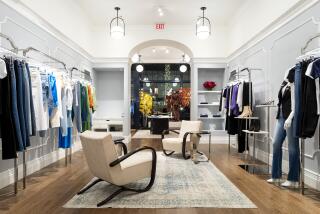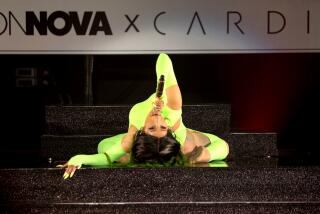One-Stop Shopping the Express Way
- Share via
From the props, you might think you had happened onto the back lot of a Madonna video: Giant gold cherubs. A fake French mantel clock the size of a refrigerator. Humongous crystal chandeliers. Sleek, ultra-modern Philippe Starck tables. And a dressmaker’s mannequin studded with hundreds of dried red roses.
But this is not the stuff of a Madonna takeoff on Marie Antoinette. Rather, it’s a few of the latest trappings at Express, one of the most familiar names in retailing. The new decor is not yet standard issue in the 518 stores nationwide, but it’s on display in the just-expanded Beverly Center branch, now the chain’s largest.
Encompassing about 25,000 square feet, this super store is actually three shops in one: Express carries women’s wear, Structure houses menswear, and Bath & Body Works, a shop modeled on a French country store, specializes in personal-care products.
Structure, which is less whimsical and more serious-looking than Express, is outfitted with props from the world of design, such as a stylish architect’s table.
Like Express, it concentrates on natural-fiber fashions at moderate prices, with a few higher-end items such as leather coats and jackets. Unlike Express, Structure also carries books on architecture, design and photography, including the Herb Ritts and Dennis Hopper coffee-table albums.
Bath & Body Works, situated between Express and Structure, also offers books, but on such subjects as aroma therapy, potpourri and personal ecology. All the body lotions, shampoos, bubble baths and other products come in plastic bottles, and the store will recycle the empties.
Express is a division of Columbus, Ohio-based The Limited, which many retailing consultants consider to be the most successful apparel chain in the country--and one of the most copied.
The firm will continue its expansion plans in 1991 despite predictions that the retail slump will continue, says Michael Weiss, president of Express.
“We plan to open at least 50 more stores in 1991,” Weiss says. “I think it’s a question of seeing opportunities, seeing where you’re at and being aggressive about it.”






